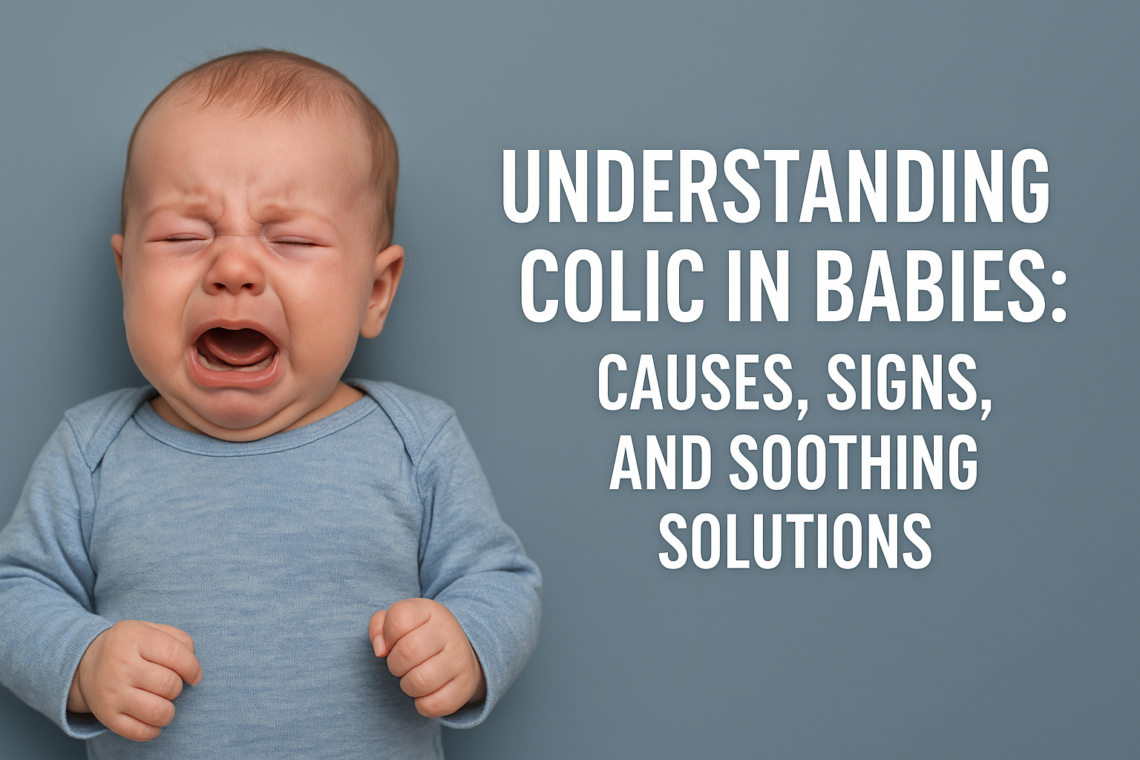Caring for a baby with colic can be emotionally and physically exhausting. Colic is a common yet puzzling condition marked by excessive, unexplained crying. This blog explores what colic is, how to recognize it, and the best science-backed ways to help your baby—and yourself—through it.
👶 What Is Colic?
Colic is defined as frequent, prolonged, and intense crying in an otherwise healthy infant. Pediatricians often apply the “Rule of 3s” to identify it:
Crying for more than 3 hours a day, more than 3 days a week, for at least 3 weeks.
It usually begins at around 2–3 weeks of age and typically resolves by 3–4 months.
📊 Colic vs Normal Crying
| Feature | Normal Crying | Colic Crying |
|---|---|---|
| Frequency | Intermittent | Daily, often same time of day |
| Duration | Less than 2 hours/day | Often 3+ hours/day |
| Cause | Hunger, discomfort, tiredness | No clear cause |
| Baby’s behavior | Easily soothed | Difficult or impossible to soothe |
| Baby’s health | Calm after needs are met | Otherwise healthy and growing |
🔍 Signs and Symptoms of Colic
- Intense crying episodes, often in the late afternoon or evening
- Clenched fists, arched back, and tightened abdominal muscles
- Pulling legs toward the belly
- Flushed face or pale around the mouth
- Passes gas (may indicate swallowed air during crying)
🧪 What Causes Colic?
The exact cause of colic is unknown, but leading theories include:
| Theory | Details |
|---|---|
| Gastrointestinal discomfort | Immature digestion, gas, or reflux may contribute |
| Food sensitivities | Reaction to formula or something in breastfeeding mom’s diet (e.g., dairy) |
| Immature nervous system | Overstimulation or difficulty self-soothing |
| Microbiome imbalance | Gut bacteria imbalance may be linked |
| Parental anxiety or stress | Babies may pick up on caregiver stress, increasing crying |
🛠️ How to Manage and Soothe a Colicky Baby
✅ 1. Establish a Soothing Routine
Consistency is comforting. Try:
- Warm bath
- Gentle rocking or bouncing
- Soft white noise or lullabies
- Dim lighting in the evening
✅ 2. Hold Baby Upright After Feeding
This reduces reflux and helps with digestion. Burp frequently during and after feeding.
✅ 3. Try the “5 S’s” by Dr. Harvey Karp
- Swaddling – Secure but not too tight
- Side/Stomach Position – For soothing (not sleep)
- Shushing – Mimics womb sounds
- Swinging – Gentle motion soothes the nervous system
- Sucking – Pacifier or breast helps calm the baby
✅ 4. Track and Eliminate Potential Triggers
- If breastfeeding, try a dairy-free diet for 1–2 weeks
- Experiment with hypoallergenic formula if bottle-feeding
- Use a colic diary to track patterns (e.g., time of day, feeding type)
✅ 5. Consider Probiotics
Studies show the probiotic Lactobacillus reuteri may reduce crying time in some infants with colic (especially breastfed babies). Always consult your pediatrician before use.
🛑 What NOT to Do
- ❌ Never shake your baby. If you feel overwhelmed, place the baby in a safe place and take a short break.
- ❌ Don’t overfeed trying to soothe with feeding alone.
- ❌ Avoid random over-the-counter remedies without pediatric guidance.
🧘♀️ Taking Care of Yourself
Parenting a colicky baby is emotionally taxing. Remember:
- It’s not your fault—colic happens even with the best care
- Ask for help: from partners, family, or friends
- Take shifts to get rest
- Talk to a pediatrician or join support groups
🏥 When to Call a Doctor
Seek medical attention if your baby:
- Isn’t gaining weight
- Has vomiting, diarrhea, or blood in stool
- Shows signs of illness (fever, lethargy)
- Has inconsistent crying that suddenly worsens
📝 Summary: Colic Survival Checklist
✅ Recognize colic vs normal crying
✅ Create a calming daily routine
✅ Use proven techniques like the 5 S’s
✅ Track and test feeding triggers
✅ Take care of your mental health
✅ Consult your pediatrician regularly
📅 Remember: Colic is Temporary
While colic can feel never-ending, most babies outgrow it by 4 months. With knowledge, patience, and the right support, you’ll get through this stage—and so will your baby.





